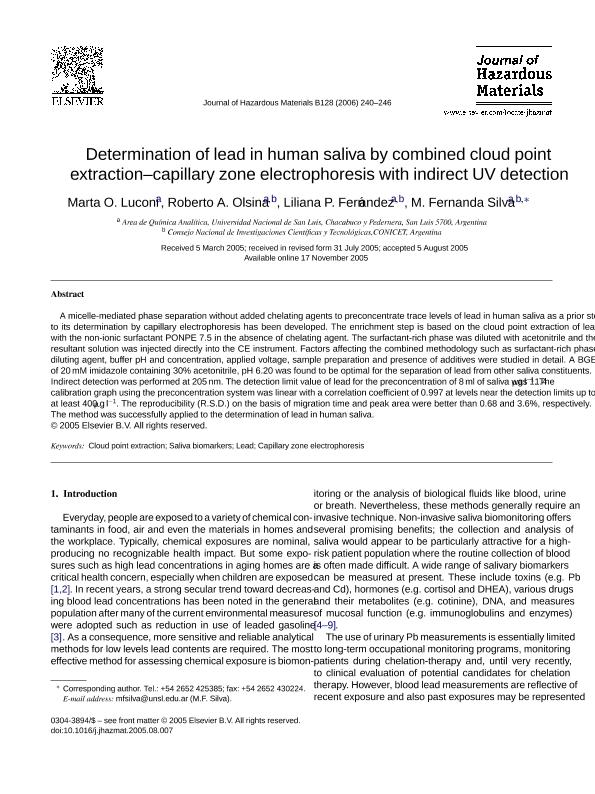Artículo
Determination of lead in human saliva by combined cloud point extraction-capillary zone electrophoresis with indirect UV detection
Fecha de publicación:
02/2006
Editorial:
Elsevier Science
Revista:
Journal of Hazardous Materials
ISSN:
0304-3894
Idioma:
Inglés
Tipo de recurso:
Artículo publicado
Clasificación temática:
Resumen
A micelle-mediated phase separation without added chelating agents to preconcentrate trace levels of lead in human saliva as a prior step to its determination by capillary electrophoresis has been developed. The enrichment step is based on the cloud point extraction of lead with the non-ionic surfactant PONPE 7.5 in the absence of chelating agent. The surfactant-rich phase was diluted with acetonitrile and the resultant solution was injected directly into the CE instrument. Factors affecting the combined methodology such as surfactant-rich phase diluting agent, buffer pH and concentration, applied voltage, sample preparation and presence of additives were studied in detail. A BGE of 20 mM imidazole containing 30% acetonitrile, pH 6.20 was found to be optimal for the separation of lead from other saliva constituents. Indirect detection was performed at 205 nm. The detection limit value of lead for the preconcentration of 8 ml of saliva was 11.4 μg l−1. The calibration graph using the preconcentration system was linear with a correlation coefficient of 0.997 at levels near the detection limits up to at least 400 μg l−1. The reproducibility (R.S.D.) on the basis of migration time and peak area were better than 0.68 and 3.6%, respectively. The method was successfully applied to the determination of lead in human saliva.
Archivos asociados
Licencia
Identificadores
Colecciones
Articulos(IBAM)
Articulos de INST.DE BIOLOGIA AGRICOLA DE MENDOZA
Articulos de INST.DE BIOLOGIA AGRICOLA DE MENDOZA
Articulos(INQUISAL)
Articulos de INST. DE QUIMICA DE SAN LUIS
Articulos de INST. DE QUIMICA DE SAN LUIS
Citación
Luconi, Marta Olga; Olsina, Roberto Antonio; Fernandez, Liliana Patricia; Silva, María Fernanda; Determination of lead in human saliva by combined cloud point extraction-capillary zone electrophoresis with indirect UV detection; Elsevier Science; Journal of Hazardous Materials; 128; 2-3; 2-2006; 240-246
Compartir
Altmétricas




